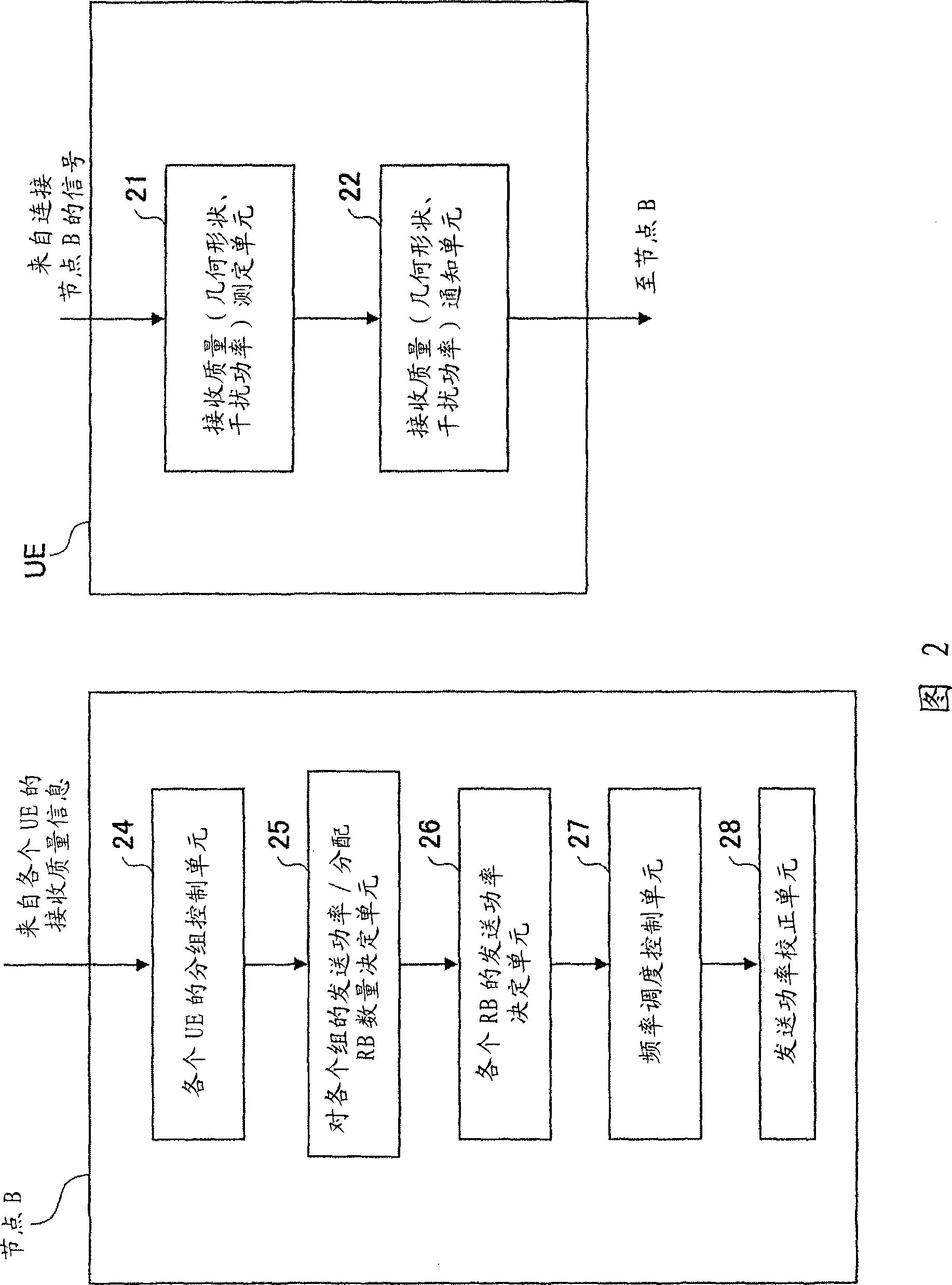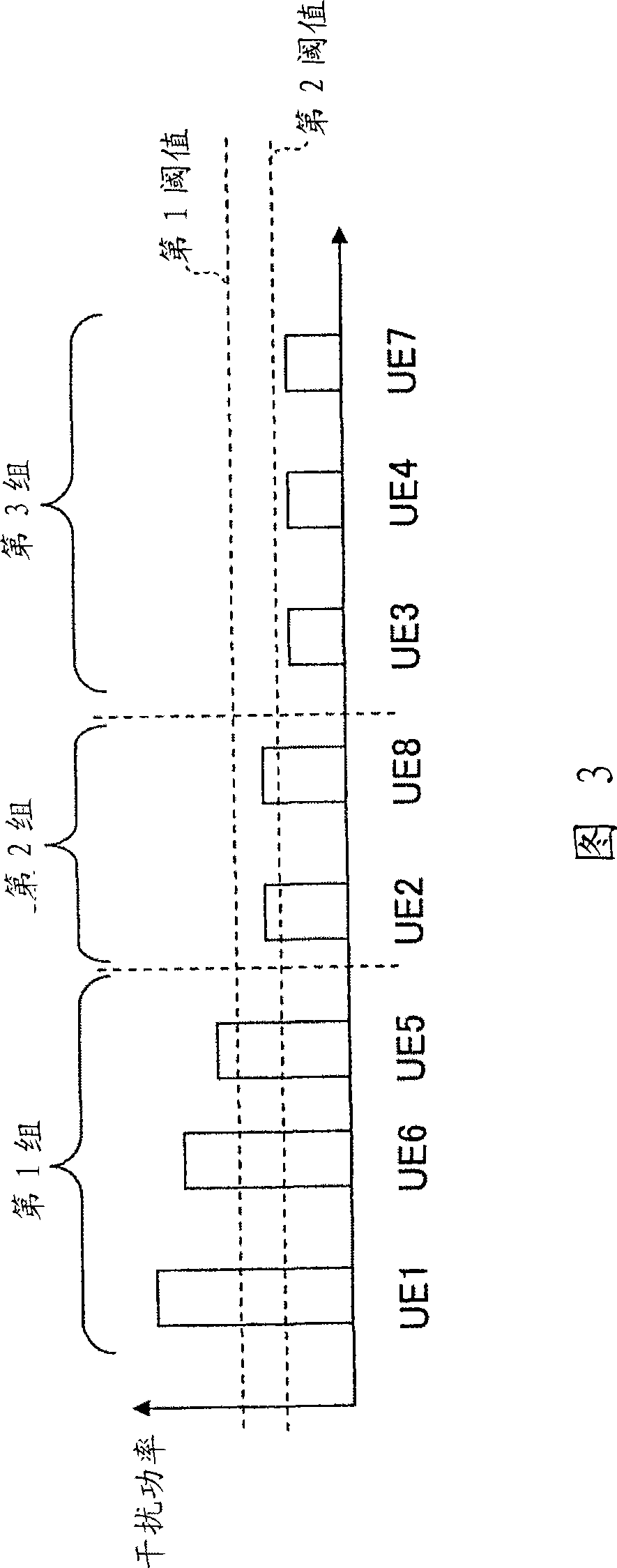Radio access network apparatus and method
A wireless access network and wireless access technology, applied in the field of mobile communications, can solve problems such as low user frequency utilization, unclear cell boundaries, and inability to fully suppress interference, so as to improve frequency utilization and suppress other cells interference effect
- Summary
- Abstract
- Description
- Claims
- Application Information
AI Technical Summary
Problems solved by technology
Method used
Image
Examples
Embodiment 1
[0039] FIG. 2 shows a mobile station UE and a base station or Node B (NodeB) according to an embodiment of the present invention. The mobile station has a reception quality measurement unit 21 and a reception quality notification unit 22 . The reception quality measurement unit 21 measures the quality of a signal (for example, a downlink pilot channel) received from a base station. The quality can be represented by various quantities, and can also be represented by interference power, geometric shape and other appropriate certain channel state information channel quality indicator (CQI: Channel quality indicator). The reception quality notification unit 22 transmits the measured value to the base station.
[0040] The base station includes a grouping control unit 24 for each UE, a determination unit 25 for transmission power and the number of allocated resource blocks (number of RBs) for each group, a transmission power determination unit 26 for each RB, a frequency schedulin...
Embodiment 2
[0049] FIG. 5 shows a mobile station UE and a base station (Node B) according to an embodiment of the present invention. As in the example shown in FIG. 2 , the mobile station includes a reception quality measurement unit 21 and a reception quality notification unit 22 , and redundant descriptions are omitted. In addition, the base station includes a grouping control unit 24 for each UE, a transmission power determination unit 25' for each group, a frequency scheduling unit 27, and a transmission power correction unit 28, as in the example shown in FIG. 2 .
[0050] The grouping control unit 24 of each UE classifies the UEs into one or more groups based on the reception quality reported from each UE.
[0051] The transmission power determining unit 25' for each group determines the transmission power for each group based on the grouping discrimination result in the grouping control unit 24. Generally, UEs belonging to a group with high interference power require high transmis...
Embodiment 3
[0058] FIG. 7 shows a mobile station UE and a base station (Node B) according to an embodiment of the present invention. As in the example shown in FIG. 2 , the mobile station includes a reception quality measurement unit 21 and a reception quality notification unit 22 , and redundant descriptions are omitted. In this embodiment, unlike the first and second embodiments, assignment of radio resources and transmission power is performed by an upper layer station of a base station such as a radio network controller (RNC). The base station transmits the reception quality reported from the mobile station using the reception quality notification unit 23, the measurement value measured by the own cell, and the like to the upper station.
[0059] Incidentally, although allocation of radio resources and transmission power is done in the radio access network device (RAN) in all the embodiments, the main processing is performed by the base station in the first and second embodiments, whi...
PUM
 Login to View More
Login to View More Abstract
Description
Claims
Application Information
 Login to View More
Login to View More - R&D
- Intellectual Property
- Life Sciences
- Materials
- Tech Scout
- Unparalleled Data Quality
- Higher Quality Content
- 60% Fewer Hallucinations
Browse by: Latest US Patents, China's latest patents, Technical Efficacy Thesaurus, Application Domain, Technology Topic, Popular Technical Reports.
© 2025 PatSnap. All rights reserved.Legal|Privacy policy|Modern Slavery Act Transparency Statement|Sitemap|About US| Contact US: help@patsnap.com



